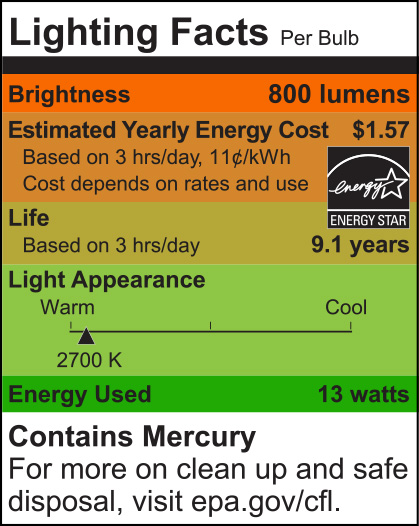Lighting Purchasing Guide
Lighting can be complicated. With so many different light bulb types to choose from, not to mention terminology like lumens, watts and color temperature, it's easy to get overwhelmed. That's why we've put together this handy lighting guide to help you keep it all straight. Just click on the desired topic below for useful information on everything from basic light bulb terminology to tips on choosing the best bulbs for your living room, patio or fixtures.
Common Types of Light Bulbs
Every type of light bulb has its purpose and it is important to understand the basic differences between them in order to find the best bulb for your lighting needs.
So, what is the longest-lasting light bulb? What is the brightest light bulb? This guide will help to answer these questions and explain the differences between fluorescent, CFL, LED, incandescent and halogen light bulb options.
| Average Life (Hours) | Wattage | Energy Usage | Color Temperature (in Kelvins) | Ideal Use | |
|---|---|---|---|---|---|

LED |
Average Life (Hours) Up to 50,000 | Wattage Up to 120 | Energy Usage Low | Color Temperature (in Kelvins) 1,100 – 5,000 | Ideal Use Household lamps or recessed lighting |

Incandescent |
Average Life (Hours) Up to 15,000 | Wattage Up to 300 | Energy Usage High | Color Temperature (in Kelvins) 2,500 – 3,000 | Ideal Use Household lamps or fixtures |

Flourescent |
Average Life (Hours) Up to 30,000 | Wattage Up to 54 | Energy Usage Medium | Color Temperature (in Kelvins) 3,500 – 5,000 | Ideal Use Shop & surface mounted lights; Commercial recessed lighting |

CFL |
Average Life (Hours) Up to 12,000 | Wattage Up to 55 | Energy Usage Medium | Color Temperature (in Kelvins) 2,700 – 5,000 | Ideal Use Household lamps or fixtures |

Halogen |
Average Life (Hours) Up to 4,000 | Wattage Up to 500 | Energy Usage High | Color Temperature (in Kelvins) 2,600 – 3,000 | Ideal Use Household track, recessed, outdoor |
Light bulb recycling available. Fees may apply and will vary by location; commercial discounts are available.
Check with your local Batteries Plus for specifics.
Color Temperature
Color temperature is a way of measuring how closely the light emitted by a light bulb resembles actual daylight and is measured in degrees Kelvin (K). Bulbs that give off a warmer, more yellowish shade of light register at a much lower K than bulbs that give off a cooler, bright white or slightly bluish hue, which is much closer to the look of daylight.
Wondering what color temperatures are best for different rooms? Check out the graphic below for a basic guide to using color temperature.
Warm White -
2400k
Soft White -
2700k & 3000k
Cool White -
4100k
Daylight -
5000k
Living Room - Soft White & Warm Light
Dining Room - Warm Light
Bedroom - Soft White & Warm White
Bathroom - Cool White
Reading Area - Daylight
Kitchen - Cool White
Workspace - Daylight & Cool White
Outdoor - Cool White
Manufacturing - Daylight
Security - Cool White
Watts & Lumens
Understanding light bulb terminology is important when selecting the right bulbs for your needs. Two of the most common lighting terms you’ll encounter are watts and lumens. See below for a brief definition of these terms and how they can help you select the best lighting options.
Wattage
Measures the amount of energy that a light bulb uses.
The lower the wattage, the less energy it needs to operate.
Since bulbs can have the same brightness while using different amounts of energy, watts are a poor way of measuring brightness.
Lumens
Standard way of measuring light bulb brightness.
Higher number of lumens signify a brighter bulb.
Need help determining the right bulb for your lighting needs?
This chart breaks down the lumens you need in order to match the brightness of your old 40-, 60-, 75- and 100-watt incandescent bulbs.
Shop for
Brightness
(Lumens)
not
Energy
(Watts)
|
Brightness in lumens |

450 Lumens |

800 Lumens |

1100 Lumens |

1600 Lumens |
|---|---|---|---|---|
 LED |
||||
 LED |
450 Lumens |
800 Lumens |
1100 Lumens |
1600 Lumens |
 CFL |
||||
 CFL |
450 Lumens |
800 Lumens |
1100 Lumens |
1600 Lumens |
 Halogen |
||||
 Halogen |
450 Lumens |
800 Lumens |
1100 Lumens |
1600 Lumens |
 Incandescent |
||||
 Incandescent |
450 Lumens |
800 Lumens |
1100 Lumens |
1600 Lumens |
Understanding Light Bulb Sizes

When you’re shopping for a new light bulb, it’s important to understand sizing to be sure it will fit in your fixture. Each bulb has a code that indicates its shape and diameter at the widest point measured in eighths of an inch.
For example, an A19 code indicates that it's a classic A-series light bulb with a diameter of 19 eighths of an inch (2.38 inches or 60.33mm). To get the correct width measurement, be sure to measure it at the widest point, which varies with the type of bulb you're looking for.
How to Read the Labels
Light bulb labels will provide you with all of the information you need to help you find the bulb best suited to your desired application.
Lumens
Measurement of the brightness (light output) of the light bulb. The higher the lumens, the brighter the light bulb. You will want to look for lumens now vs. watts when shopping for brightness of light bulbs.
Estimated Yearly Energy Cost
Based on three hours of use per day at the average U.S. electricity price of 11 cents per kilowatt hour. This cost may vary based on local electricity rates and how long your lights are on.
Life
How long your light bulb is expected to last based on being turned on for three hours per day.
Light Appearance
The light bulb's color temperature and is measured on a Kelvin (k) scale ranging from 2700k–6500k. Light bulbs with a color temperature in the warm range (2900–3000k) will have a softer yellowish light. Light bulbs that are labeled cool white and have 4100k temperature have whiter light whereas light bulbs with 5000k to 6500k are meant to mimic natural daylight.
Energy Used
Measurement in wattage of the light bulb. The 200 EISA Legislation requires that new light bulbs use 25% less energy than traditional incandescent light bulbs. Many of the new energy saving LED, CFL and halogen light bulbs consume less energy.
Energy Star
The ENERGY STAR logo on the label means that the U.S. government has recognized this product as providing significant energy savings without sacrificing performance. It also highlights that while the product might cost more up-front, customers will recoup this additional investment through long-term energy savings.

Smart Lighting FAQs
Smart home technology allows homeowners to control their lights through apps on their networked devices, like smartphones or tablets. Smart home systems often work together to automate actions based on the user's preferences for easy and customized operation.
The best smart home devices are those that work with or without a hub, since they allow any customer to purchase them and try them out. Batteries Plus Bulbs carries a variety of smart home devices that are compatible with top-rated brands including Amazon Alexa, Apple Home Kit, Google Assistant, Nest and Windows Cortana.
The Geeni strip light is our most popular smart lighting item and is great for adding additional light or color to dark spaces such under or above cabinets, above pictures or even outside.
Smart lighting provides homeowners with greater security, convenience, comfort, and energy-efficiency. It's great for reducing energy bills and offers increased security by allowing you to control your lights when you're not at home. Many smart light bulbs also change colors, making it easy to create different moods without having to change bulbs.
The most basic requirements are a single smart light bulb, together with a smartphone, tablet or other voice-enabled smart device. It's easy to add additional components whenever you wish. If you use a variety of different smart home devices or services, you might need a smart home system hub. This is the hardware or software that centrally connects all the devices on your network so you can control them more efficiently.
Yes, they do, however, in order to work it is important to leave them switched on at all times. Otherwise, you will not be able to turn the light on remotely via the app
This is really a matter of customer preference. If a user wants lighting fixtures or entire rooms to be automated, a smart switch allows the customer to go "smart" without needing to relamp every fixture with new bulbs.
If a user wants the option of controlling different fixtures at different times or of cycling between the different colors on a color changing bulb, they should go with smart bulbs.
Yes, smart home products must be connected to Wi-Fi in order to function properly
No, smart lighting does not use any more electricity than a normal light, however, they can save energy due to the ability to schedule lights to turn on and off at specific times. With smart lights, you no longer need to keep lights on all day in order to avoid coming home to a dark house, since you can schedule them to turn on when the sun goes down.
Smart lights are easy to install. Simply, plug the bulb in, set the Geeni app, connect to the internet and you’re ready to go.
Do you have questions about how to install and pair your new smart home devices? Batteries Plus Bulbs has you covered. Get help installing your smart home devices by checking out our helpful videos.
Smart Home enables you to turn lights on and off, along with a variety of other home-related tasks through the use of an app on your cell phone or tablet. Smart Home products are becoming more and more common, due to their convenience and security applications. Here are a few frequently asked questions about what Smart Home is and what it can do for you.